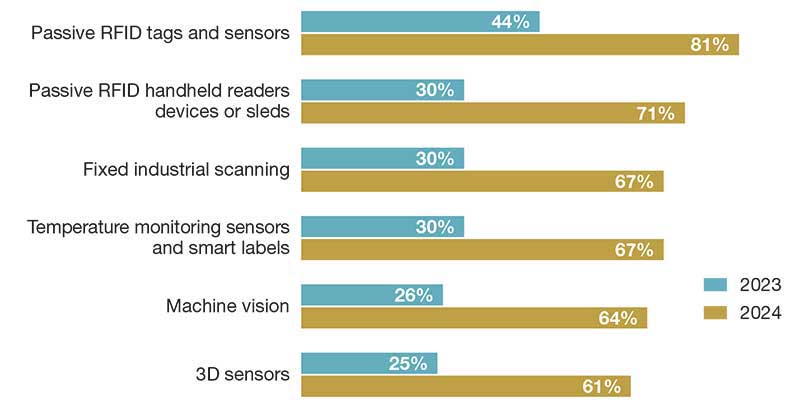Automatic Data Capture (ADC): Accelerating the Process
The push is on to get to the next level of productivity and workflow efficiency with automatic data capture technologies.

As surprising as it might be, a large number of warehouses and distribution centers still rely on pencil and paper to identify and track inventory.
That said, even more facilities do use some form of automatic data capture technology and still don’t feel as if they are sufficiently efficient or accurate in tracking inventory.
Both are eerily in the same place given today’s emphasis on ways to make warehouse operations more productive short term (as in right away) or long term (as in the next quarter).
“It’s all about accelerating the order management process,” explains Andre Luecht, Zebra Technologies’ global strategy lead for transportation, logistics and warehouse.
“Operations managers have a sharp focus on fine tuning the process for speed without sacrificing flexibility. In most cases, it’s a matter of synchronizing automatic data capture (ADC) technologies with warehouse management systems (WMS) that manage activities and workflows on the floor,” Luecht continues.
In late September, Zebra released the results of its global warehousing survey. It showed that 73% of ADC decision makers already have or will speed up modernization projects. Quite simply, they are under pressure to find ways to unlock improved efficiencies.
That said, Luecht sees a shift in what is receiving investment money going forward.
“For the past 18 months, people have been buying all kinds of automation, not just ADC, to modernize their facilities following the initial shock of Covid,” says Luecht.
“In the next 12 months, the emphasis is going to be on specific investments in specific use cases. Investment dollars will be tight and the cost of capital will be high. The outcome will be a focus on low-risk projects. And that’s where ADC shines,” Luecht adds.
At the same time, decision makers are less likely right now to go all in with just one technology, adds Luecht. “They want multiple technologies that minimize risk to ADC system success and without a premium cost,” he adds.
From discussions with him and others, voice, RFID and vision are three technologies likely to be key investments going forward.
You may have noticed that bar codes were not mentioned yet. Don’t panic. Bar codes, including QR codes, are still the backbone of automatic data capture. However, this time around we’ve decided to focus on other technologies instead. We’ll get back to bar codes in a future article.
Filling orders with voice
“If you’ve got a high-velocity picking operation, voice deserves consideration,” says Peak Technologies’ director of solutions engineering Dan McCabe. He calls it the “sweet spot” for voice.
An example of that is Orgill, the world’s largest independently owned hardlines distributor with $3.6 billion in sales. The company’s Rome, N.Y., DC fulfills orders for its customers and is also an order fulfillment center for retailers from hardware to farm stores.
Associates are expected to make a pick at least every 22 seconds. Order fulfillment is powered by the Jennifer voice system, which acts as the brain, voice and orchestration engine of the system, explains Mark McCleary, chief technology officer at Lucas.
Voice directs picks for a single order that can range from 1 to 150 lines per customer. Up to four customers can be managed per assignment.

On the e-commerce side, the voice-directed optimization process, says McCleary, picks items for as many as 99 customers in the same tote at the same time.
The results are notable. Roughly one pick is made every 22 seconds. And picking accuracy is 99.6%. A warehouse optimization software suite coordinates efficiency and accuracy of the fulfillment process.
As McCleary explains, “voice is a tool, not magic.” He says voice is all about “putting data at associates’ fingertips in real time so they can make decisions in real time.”
It’s also worth differentiating grammar-restricted voice systems such as Jennifer from large language models such as Siri and Alexa that use copious amounts of data to train it. That grammar restriction means the typical warehouse voice system today is speaker independent and does not require much, if any, training. In other words, associates can start using the system almost immediately.
Meanwhile, Ryan Absil, director of professional services at EPG, says the supplier’s latest version of LYDIA Voice, No. 9 to be exact, features a speaker-independent recognition engine across more than 50 languages. It recognizes multiple languages in parallel and real time.

Source: Zebra
Absil adds that no voice training is needed especially with a speech recognition engine that is powered, at least in part, by artificial intelligence. “Users can select their preferred output language and reply in the language of their choice,” says Absil. Furthermore, input languages can be changed on the fly, during order processing if desired.
In addition, says EPG’s principal of pre-sales Rishabh Singhvi, users can now replace a headset with a Voice Wear lightweight vest.
“Beyond traditional hands-free, eyes-free headsets, the new ergonomic vest makes voice head-free. It’s about working more efficiently rather than working harder,” says Singhvi.
Interest in various ADC technologies
With its voice system already in place, Orgill is leading a trend to investing in technologies that shift warehouse associates’ attention to more customer-centric, high-value tasks. With that in mind, 69% of respondents to that Zebra survey say they have already or are planning to automate workflows in 2024.
The survey continues to explain that more than three-quarters of both decision makers and associates say they need better inventory management tools to improve accuracy.
The chart on page 41 shows plans decision makers have for implementing a range of ADC technologies in the next year. Passive RFID technology holds the top two spots on the list. Other inclusions are fixed position scanners, sensors for Internet of Things networks and vision systems.
RFID in particular
If you haven’t looked at RFID lately, now would be a good time. And many are already on that path.
“We’ve seen RFID implementations pick up lately,” says McCabe of Peak. “From where we sit, RFID implementations are all about the difficulty of finding labor.”
Meanwhile, Luecht says regulations from food to drugs are also helping drive interest in the technology. RFID provides comprehensive tracking of items all the way through the supply chain including additional related data required to meet regulatory requirements.
Meanwhile, Zebra has introduced what it calls a portfolio of easy-to-deploy RFID portals that provide improved read rates. They can be used throughout the facility from dock doors to conveyors, storage locations and even on lift trucks.
The new technology will “elevate the performance of every system, device, tag and worker,” says Matt Seltz, general manager of location solutions at Zebra. The RFID portals allow organizations “to know where their assets are any point in time and help increase the accuracy and speed of receiving, putaway, consume and resell,” adds Seltz.
A better view
“Warehouse leaders are investing in technology innovation and intelligent automation to increase inventory resiliency and visibility,” says the Zebra report. And when it comes to vision systems, visibility takes on a whole new meaning.
While vision is hardly a new technology, its use is hardly as widespread as other ADC technologies. In fact, only about 25% of users are even investigating vision systems this year. But that is about to change rapidly as 61% of Zebra’s survey respondents say 2024 will see interest in vision systems.
While often thought of as a quality control tool, vision systems fit right into the data capture network.
Cognex recently focused on vision and optimal label placement. As the company explains, any carton can easily have a range of labels on it from case marking and hazardous materials labels to company logos. Yet, there still has to be a best place to apply a shipping label.
With that in mind, Cognex offers a vision system with 2D and 3D cameras that capture a high-resolution, high-quality image of the carton and its surfaces. With artificial intelligence, the system determines label placement almost without hesitation despite carton-to-carton-to-carton uniqueness.
Vision systems are also in Zebra’s line of sight. Last year, the company purchased Matrox Imaging, a developer of advanced machine vision components, software and systems.
The company’s technology uses 360-degree scan tunnels to read labels with optical character recognition technology on a variety of items and inventory. The technology complements Zebra’s Aurora software that reads OCR data at a high speed.

Improving microflows
So far, we’ve focused on trends in ADC technologies to improve workflow. But what about the workflow itself? Dan Gilmore, vice president of marketing at Softeon, has some thoughts on that.
He calls them microflows. What Gilmore is talking about is the sequence dictated by the WMS for a worker to pick and confirm accuracy of a pick. Should the item be scanned first? Or the location? Or the tote that the item is placed into?
“While the WMS sets out a sequence, it may not actually be the most efficient sequence for the worker based on any number of conditions,” says Gilmore.
As a result, you need a capability to alter that microflow. “It’s not uncommon to pick up a 10% jump in productivity by reordering the sequence of activities,” says Gilmore.
He continues on to say it’s all about the WMS and a user interface tool that allows changes in the sequence without being unnecessarily disruptive.
Clearly, ADC is at the center of the battle for greater warehouse productivity and efficiency. And fortunately, there are lots of great options to make important gains from workflow to microflows.

Article Topics
Latest in Materials Handling
Geek+ and System Teknik deploy PopPick solution for pharmacy group Med24.dk Beckhoff USA opens new office in Austin, Texas Manhattan Associates selects TeamViewer as partner for warehouse vision picking ASME Foundation wins grant for technical workforce development The (Not So) Secret Weapons: How Key Cabinets and Asset Management Lockers Are Changing Supply Chain Operations MODEX C-Suite Interview with Harold Vanasse: The perfect blend of automation and sustainability Consultant and industry leader John M. Hill passes on at age 86 More Materials HandlingAbout the Author
Subscribe to Materials Handling Magazine

Find out what the world's most innovative companies are doing to improve productivity in their plants and distribution centers.
Start your FREE subscription today.
April 2024 Modern Materials Handling

Latest Resources










